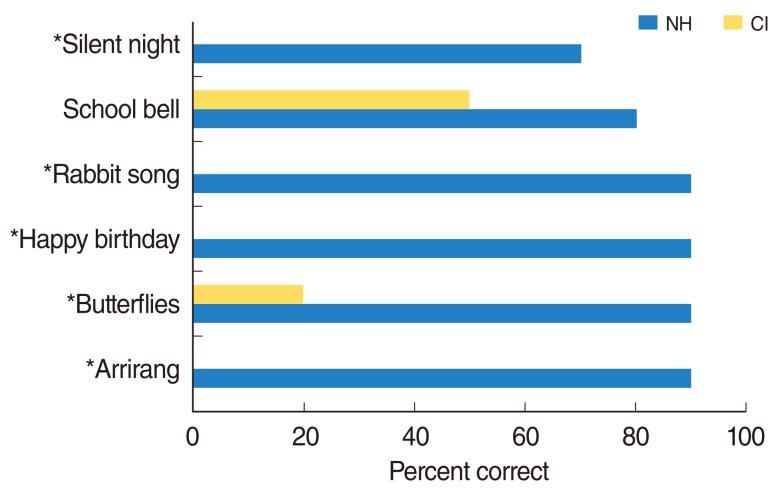Clin Exp Otorhinolaryngol.
2012 Apr;5(Suppl 1):S53-S58.
Music Perception Ability of Korean Adult Cochlear Implant Listeners
- Affiliations
-
- 1Department of Otorhinolaryngology-Head & Neck Surgery, Hallym Sacred Heart Hospital, Hallym University College of Medicine, Anyang, Korea. hjk1000@hallym.or.kr
Abstract
OBJECTIVES
Although the cochlear implant (CI) is successful for understanding speech in patients with severe to profound hearing loss, listening to music is a challenging task to most CI listeners. The purpose of this study was to assess music perception ability and to provide clinically useful information regarding CI rehabilitation.
METHODS
Ten normal hearing and ten CI listeners with implant experience, ranging 2 to 6 years, participated in the subtests of pitch, rhythm, melody, and instrument. A synthesized piano tone was used as musical stimuli. Participants were asked to discriminate two different tones during the pitch subtest. The rhythm subtest was constructed with sets of five, six, and seven intervals. The melody & instrument subtests assessed recognition of eight familiar melodies and five musical instruments from a closed set, respectively.
RESULTS
CI listeners performed significantly poorer than normal hearing listeners in pitch, melody, and instrument identification tasks. No significant differences were observed in rhythm recognition between groups. Correlations were not found between music perception ability and word recognition scores.
CONCLUSION
The results are consistent with previous studies that have shown that pitch, melody, and instrument identifications are difficult to identify for CI users. Our results can provide fundamental information concerning the development of CI rehabilitation tools.
Figure
Reference
-
1. Drennan WR, Rubinstein JT. Music perception in cochlear implant users and its relationship with psychophysical capabilities. J Rehabil Res Dev. 2008; 45(5):779–789. PMID: 18816426.
Article2. Gfeller K, Witt S, Stordahl J, Mehr M, Woodworth G. The effect of training on melody recognition and appraisal by adult cochlear implant recipients. J Acad Rehabil Audiol. 2000; 33:115–138.3. McDermott HJ. Music perception with cochlear implants: a review. Trends Amplif. 2004; 6. 8(2):49–82. PMID: 15497033.
Article4. Gfeller K, Woodworth G, Robin DA, Witt S, Knutson JF. Perception of rhythmic and sequential pitch patterns by normally hearing adults and adult cochlear implant users. Ear Hear. 1997; 6. 18(3):252–260. PMID: 9201460.
Article5. Kong YY, Cruz R, Jones JA, Zeng FG. Music perception with temporal cues in acoustic and electric hearing. Ear Hear. 2004; 4. 25(2):173–185. PMID: 15064662.
Article6. Burkholder RA, Pisoni DB, Svirsky MA. Effects of a cochlear implant simulation on immediate memory in normal-hearing adults. Int J Audiol. 2005; 10. 44(10):551–558. PMID: 16317807.
Article7. Fu QJ, Nogaki G. Noise susceptibility of cochlear implant users: the role of spectral resolution and smearing. J Assoc Res Otolaryngol. 2005; 3. 6(1):19–27. PMID: 15735937.
Article8. Nie K, Barco A, Zeng FG. Spectral and temporal cues in cochlear implant speech perception. Ear Hear. 2006; 4. 27(2):208–217. PMID: 16518146.
Article9. Looi V, She J. Music perception of cochlear implant users: a questionnaire, and its implications for a music training program. Int J Audiol. 2010; 2. 49(2):116–128. PMID: 20151886.
Article10. Nimmons GL, Kang RS, Drennan WR, Longnion J, Ruffin C, Worman T, et al. Clinical assessment of music perception in cochlear implant listeners. Otol Neurotol. 2008; 2. 29(2):149–155. PMID: 18309572.
Article11. Jung KH, Cho YS, Cho JK, Park GY, Kim EY, Hong SH, et al. Clinical assessment of music perception in Korean cochlear implant listeners. Acta Otolaryngol. 2010; 6. 130(6):716–723. PMID: 19958251.
Article12. Lai WK, Bogli H, Dillier N. A software tool for analyzing multichannel cochlear implant signals. Ear Hear. 2003; 10. 24(5):380–391. PMID: 14534409.13. Grahn JA, Brett M. Impairment of beat-based rhythm discrimination in Parkinson's disease. Cortex. 2009; 1. 45(1):54–61. PMID: 19027895.
Article14. Kang R, Nimmons GL, Drennan W, Longnion J, Ruffin C, Nie K, et al. Development and validation of the University of Washington Clinical Assessment of Music Perception test. Ear Hear. 2009; 8. 30(4):411–418. PMID: 19474735.
Article15. Galvin JJ 3rd, Fu QJ, Nogaki G. Melodic contour identification by cochlear implant listeners. Ear Hear. 2007; 6. 28(3):302–319. PMID: 17485980.
Article16. Gfeller K, Witt S, Woodworth G, Mehr MA, Knutson J. Effects of frequency, instrumental family, and cochlear implant type on timbre recognition and appraisal. Ann Otol Rhinol Laryngol. 2002; 4. 111(4):349–356. PMID: 11991588.
Article17. Driscoll VD, Oleson J, Jiang D, Gfeller K. Effects of training on recognition of musical instruments presented through cochlear implant simulations. J Am Acad Audiol. 2009; 1. 20(1):71–82. PMID: 19927684.
Article18. Kong YY, Stickney GS, Zeng FG. Speech and melody recognition in binaurally combined acoustic and electric hearing. J Acoust Soc Am. 2005; 3. 117(3 Pt 1):1351–1361. PMID: 15807023.
Article
- Full Text Links
- Actions
-
Cited
- CITED
-
- Close
- Share
- Similar articles
-
- A Review of Music Perception with Cochlear Implantation
- Efficacy of Music Training in Hearing Aid and Cochlear Implant Users: A Systematic Review and Meta-Analysis
- Meta-Analysis Exploring the Effects of Music Training in Cochlear Implant Users by Age
- Substitution Patterns of Phoneme Errors in Hearing Aid and Cochlear Implant Users
- Behavioral Perception and Neural Correlates of Categorical Perception in Cochlear Implant Users







